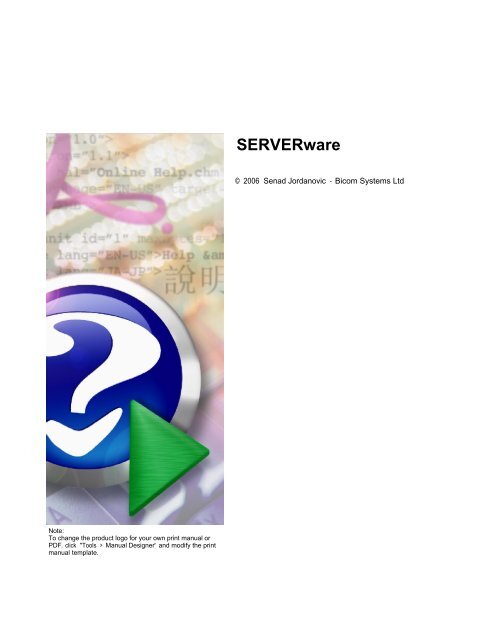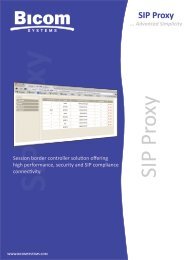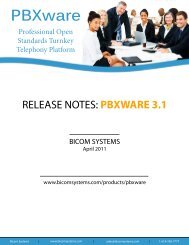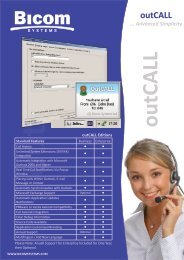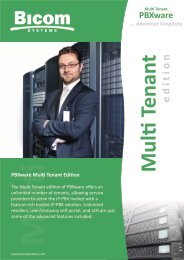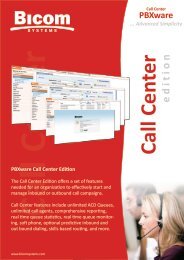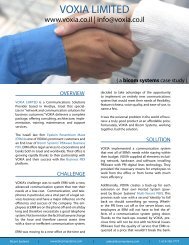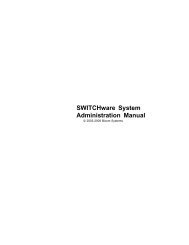SERVERware.pdf - Bicom Systems
SERVERware.pdf - Bicom Systems
SERVERware.pdf - Bicom Systems
Create successful ePaper yourself
Turn your PDF publications into a flip-book with our unique Google optimized e-Paper software.
<strong>SERVERware</strong><br />
© 2006 Senad Jordanovic - <strong>Bicom</strong> <strong>Systems</strong> Ltd<br />
Note:<br />
To change the product logo for your own print manual or<br />
PDF, click "Tools > Manual Designer" and modify the print<br />
manual template.
Title page 1<br />
Use this page to introduce the product<br />
by Senad Jordanovic - <strong>Bicom</strong> <strong>Systems</strong> Ltd<br />
This is "Title Page 1" - you may use this page to introduce<br />
your product, show title, author, copyright, company logos,<br />
etc.<br />
This page intentionally starts on an odd page, so that it is on<br />
the right half of an open book from the readers point of view.<br />
This is the reason why the previous page was blank (the<br />
previous page is the back side of the cover)
<strong>SERVERware</strong><br />
© 2006 Senad Jordanovic - <strong>Bicom</strong> <strong>Systems</strong> Ltd<br />
All rights reserved. No parts of this work may be reproduced in any form or by any means - graphic, electronic, or<br />
mechanical, including photocopying, recording, taping, or information storage and retrieval systems - without the<br />
written permission of the publisher.<br />
Products that are referred to in this document may be either trademarks and/or registered trademarks of the<br />
respective owners. The publisher and the author make no claim to these trademarks.<br />
While every precaution has been taken in the preparation of this document, the publisher and the author assume no<br />
responsibility for errors or omissions, or for damages resulting from the use of information contained in this document<br />
or from the use of programs and source code that may accompany it. In no event shall the publisher and the author be<br />
liable for any loss of profit or any other commercial damage caused or alleged to have been caused directly or<br />
indirectly by this document.<br />
Printed: December 2006 in (whereever you are located)<br />
Publisher<br />
...enter name...<br />
Managing Editor<br />
...enter name...<br />
Technical Editors<br />
...enter name...<br />
...enter name...<br />
Special thanks to:<br />
All the people who contributed to this document, to mum and dad<br />
and grandpa, to my sisters and brothers and mothers in law, to our<br />
secretary Kathrin, to the graphic artist who created this great<br />
product logo on the cover page (sorry, don't remember your name<br />
at the moment but you did a great work), to the pizza service down<br />
the street (your daily Capricciosas saved our lives), to the copy<br />
shop where this document will be duplicated, and and and...<br />
Last not least, we want to thank EC Software who wrote this great<br />
help tool called HELP & MANUAL which printed this document.<br />
Cover Designer<br />
...enter name...<br />
Team Coordinator<br />
...enter name...<br />
Production<br />
...enter name...
4<br />
<strong>SERVERware</strong><br />
Table of Contents<br />
Foreword 5<br />
Part I Introduction 7<br />
1 Management ................................................................................................................................... 8<br />
2 Flexibility<br />
................................................................................................................................... 9<br />
3 Self Healing................................................................................................................................... 10<br />
4 Scalability<br />
................................................................................................................................... 10<br />
5 Available VPSes ................................................................................................................................... 11<br />
Part II Controller Unit 13<br />
1 Server Operations ................................................................................................................................... 14<br />
2 Network Resources ................................................................................................................................... 15<br />
3 Network Storage ................................................................................................................................... 17<br />
4 Network Status ................................................................................................................................... 18<br />
5 Duplication Agents ................................................................................................................................... 20<br />
6 Hosts Provisioning ................................................................................................................................... 21<br />
Part III Optional Components 24<br />
Index 0<br />
© 2006 Senad Jordanovic - <strong>Bicom</strong> <strong>Systems</strong> Ltd
Foreword<br />
5<br />
Foreword<br />
This is just another title page<br />
placed between table of contents<br />
and topics<br />
© 2006 Senad Jordanovic - <strong>Bicom</strong> <strong>Systems</strong> Ltd
Top Level Intro<br />
This page is printed before a new<br />
top-level chapter starts<br />
Part<br />
I
Introduction 7<br />
1 Introduction<br />
<strong>SERVERware</strong> is a next generation communication technology solution delivering a wide range of<br />
applications in redundant, high availability or fault tolerant configurations. It features comprehensive<br />
management, flexibility, self healing and an unlimited scalability of host and virtual servers needed for<br />
today's communications needs.<br />
Features:<br />
· Browser or CLI management<br />
· Highly available virtual servers<br />
· Central network storage<br />
· Network resources monitoring<br />
· Network servers monitoring<br />
· Real time or time based virtual servers duplication<br />
· Auto hosts provisioning<br />
· Virtual servers templates<br />
© 2006 Senad Jordanovic - <strong>Bicom</strong> <strong>Systems</strong> Ltd
8<br />
<strong>SERVERware</strong><br />
1.1 Management<br />
Management<br />
The controller unit offers command line and web interface management and monitoring of all servers<br />
on the network. Command line administration is performed by using SSH while web administration is<br />
© 2006 Senad Jordanovic - <strong>Bicom</strong> <strong>Systems</strong> Ltd
Introduction 9<br />
supported using Firefox and Internet Explorer web browsers.<br />
1.2 Flexibility<br />
Flexibility<br />
<strong>SERVERware</strong> features virtual servers allowing any compatible application to be offered to the<br />
network. Each host server is able to contain many virtual servers. The number of virtual servers on<br />
each host is limited by host hardware specifications and performance. Should a network require<br />
additional applications or services, additional hosts can be automatically added. This in turn allows<br />
unlimited virtual servers and applications to be delivered to users.<br />
© 2006 Senad Jordanovic - <strong>Bicom</strong> <strong>Systems</strong> Ltd
10<br />
<strong>SERVERware</strong><br />
1.3 Self Healing<br />
Self Healing and Redundancy:<br />
Any virtual server can operate from any host server. This means that should any host server fail, the<br />
netMON agent will detect the failure and "heal" network by re-starting the virtual server(s) on another<br />
host. This is possible because the netDUPLO agents duplicates entire virtual server to the network<br />
storage at pre-set time interval.<br />
1.4 Scalability<br />
Scalability<br />
Controller manages up to 256 host and virtual servers per network site. An organization could have<br />
© 2006 Senad Jordanovic - <strong>Bicom</strong> <strong>Systems</strong> Ltd
Introduction 11<br />
many network sites. This fact allows adding an unlimited number of virtual servers. Since each virtual<br />
server can serve many type of applications this results in an organization having an unlimited number<br />
of PBX systems, gateways, soft switches, web servers or any other type of applications.<br />
1.5 Available VPSes<br />
PBXware<br />
SWITCHware<br />
GATEware<br />
CALLware<br />
MEDIAware<br />
TELCOware<br />
Please see www.bicomsystems.com for further details on above.<br />
© 2006 Senad Jordanovic - <strong>Bicom</strong> <strong>Systems</strong> Ltd
Top Level Intro<br />
This page is printed before a new<br />
top-level chapter starts<br />
Part<br />
II
Controller Unit 13<br />
2 Controller Unit<br />
The controller is a "brain" of the <strong>SERVERware</strong> making sure all hosts, data, applications and services<br />
are highly available and present. In its core, <strong>SERVERware</strong> features essential network services offered<br />
to host and virtual servers. Default standard services included are:<br />
· Network Storage<br />
· Host Provisioning<br />
· Duplication Agents<br />
· Network Monitoring<br />
· Network Resources<br />
· Management Interface<br />
The above configuration should be installed on a redundant server hardware for maximum uptime.<br />
© 2006 Senad Jordanovic - <strong>Bicom</strong> <strong>Systems</strong> Ltd
14<br />
<strong>SERVERware</strong><br />
However, for even better redundancy the controller can be configured in high availability mode using<br />
serDUPLO agent responsible to duplication of storage from primary to secondary server. For this<br />
configuration, two identical servers are required. Please see optional components for further details.<br />
The controller unit can be setup in redundant, high availability or fault tolerant operation modes:<br />
Redundant<br />
Redundant operation mode features redundant power supplies, RAID disk system and redundant fans<br />
High Availability<br />
This operation mode requires two servers. These servers are then setup in a primary/secondary<br />
operation mode. All controller unit services are started on primary server and secondary server is set<br />
to monitor the primary server for normal operation. Should secondary server find any operation<br />
abnormality, it will within few seconds change its identity to primary server and restart controller<br />
services.<br />
Fault Tolerant<br />
Fault tolerant operation mode uses fault tolerant duplicated hardware and software in order to set full<br />
fault tolerant operation mode for controller unit. This is achieved by using fault tolerant Linux and step<br />
lock technologies. Fault tolerant configuration require use of fault tolerant hardware. Please visit http://<br />
www.bicomsystems.com/products/C/P/319/255_2797/ for further details.<br />
2.1 Server Operations<br />
<strong>SERVERware</strong> allows an authorized user to perform a variety of essential actions to network hosts and<br />
virtual server.<br />
HOSTS<br />
Actions possible to hosts are:<br />
Add, Delete, Edit and view host resources statistics.<br />
VIRTUAL SERVERS<br />
Actions possible to virtual servers are:<br />
Add, Delete, Copy, Move, Start, Restart and Edit and view virtual server statistics.<br />
© 2006 Senad Jordanovic - <strong>Bicom</strong> <strong>Systems</strong> Ltd
Controller Unit 15<br />
2.2 Network Resources<br />
netRES<br />
Network Resources Agent (netRES) is responsible for monitoring essential resources on hosts and<br />
virtual servers. It keeps an accurate data on all hosts and virtual servers on the network in order to<br />
allow other <strong>SERVERware</strong> components access to its data. Resources monitored are: System load,<br />
CPU usage, memory status, file system usage and bandwidth utilization. netRES agent is installed on<br />
controller and each host it monitors.<br />
© 2006 Senad Jordanovic - <strong>Bicom</strong> <strong>Systems</strong> Ltd
16<br />
<strong>SERVERware</strong><br />
© 2006 Senad Jordanovic - <strong>Bicom</strong> <strong>Systems</strong> Ltd
Controller Unit 17<br />
2.3 Network Storage<br />
Network storage within the controller is a directory set to accept data form network hosts or other<br />
approved network services. The duplication agent netDUPLO, uses network storage to duplicate<br />
virtual servers data and its configuration. The duplication time is preset for each host. Since<br />
netDUPLO duplicates virtual servers to network storage this allows <strong>SERVERware</strong> to perform a variety<br />
of actions to virtual servers.<br />
© 2006 Senad Jordanovic - <strong>Bicom</strong> <strong>Systems</strong> Ltd
18<br />
<strong>SERVERware</strong><br />
2.4 Network Status<br />
netMON<br />
Network monitor agent (netMON) monitors hosts and virtual servers default services for normal<br />
operations. Should netMON find a virtual or host server not responding to default services within<br />
preset time value it will try getting the status of each virtual server operating from that host. Should<br />
those virtual servers not respond it shall contact resMON agent to determine at which host(s) to restart<br />
the non responsive virtual servers.<br />
NetMON will then within few seconds:<br />
1. Start the virtual servers on the controller/storage host while copying the virtual server to appropriate<br />
host<br />
© 2006 Senad Jordanovic - <strong>Bicom</strong> <strong>Systems</strong> Ltd
Controller Unit 19<br />
2. Once the copy is complete virtual server(s) will be restarted on new host.<br />
Above setup insures the minimum possible downtime.<br />
© 2006 Senad Jordanovic - <strong>Bicom</strong> <strong>Systems</strong> Ltd
20<br />
<strong>SERVERware</strong><br />
2.5 Duplication Agents<br />
Duplication agents are responsible for duplicating the virtual servers, the hosts and other important<br />
data across servers and network. It ensures that the data is current and available in case it is needed<br />
to be used on another host or virtual server. <strong>SERVERware</strong> includes two types of duplication agents:<br />
serDUPLO and netDUPLO.<br />
netDUPLO<br />
netDUPLO resides on the controller unit or separate storage server. It monitors file system changes on<br />
remote servers and copies the changes in regular time interval. This ensure that if one of hosts fails its<br />
data or virtual servers can be normally used on another host server.<br />
serDUPLO<br />
serDUPLO duplicates a disk partition from primary to secondary controller or if separate storage server<br />
© 2006 Senad Jordanovic - <strong>Bicom</strong> <strong>Systems</strong> Ltd
Controller Unit 21<br />
exists, it duplicates storage from primary storage server into secondary storage server. serDUPLO<br />
performs duplication of all data in a given disk partition in real time using high speed ethernet or<br />
dedicated interconnect technology. serDUPLO achieves this by "intercepting" all disk activity on the<br />
primary server and then sending the data to primary and secondary servers at the same time. Since<br />
netDUPLO already duplicates virtual servers onto this disk partition, this agent allows creation of extra<br />
high availability setup for controller or storage servers.<br />
PLEASE NOTE:<br />
SerDUPLO is an optional component available for controller/storage using high availability<br />
configuration.<br />
2.6 Hosts Provisioning<br />
Hosts provisioning service is responsible for allowing additional hosts to be added into the network. It<br />
stores the necessary hosts operating system template images and it starts a TFTP services in as<br />
transporting mechanism.<br />
Normally to add a host into a network requires OS installation and configuration. This takes time, it is<br />
prone to errors and above all it costs monies. Hosts provisioning service on the other hand contains a<br />
pre-configured, fully tested Linux image. This image can be requested by a host on the network and<br />
once downloaded a host will be configured and able to host virtual servers. The whole process takes<br />
few minutes, and it is fully automatic.<br />
© 2006 Senad Jordanovic - <strong>Bicom</strong> <strong>Systems</strong> Ltd
22<br />
<strong>SERVERware</strong><br />
PLEASE NOTE:<br />
Above is not implemented yet<br />
© 2006 Senad Jordanovic - <strong>Bicom</strong> <strong>Systems</strong> Ltd
Top Level Intro<br />
This page is printed before a new<br />
top-level chapter starts<br />
Part<br />
III
24<br />
<strong>SERVERware</strong><br />
3 Optional Components<br />
High availability controller or storage<br />
High availability services served from controller(s) could be setup in high availability (HA) operation<br />
mode. Two controllers are needed for this setup. Primary and Secondary.<br />
Primary controller hosts all the services while secondary controller monitors the primary for normal<br />
operation status. Should secondary controller find an abnormal operation status, it will within set period<br />
of time (usually set to few seconds) assign the high availability IP address and start all services within<br />
that controller. This ensures network services are highly available in case of primary controller<br />
hardware failure giving the opportunity to network administrator to perform hardware investigation.<br />
Database Replication<br />
Further redundancy can be achieved by implementing database replication between controllers. This is<br />
achieved by replicating database from one server to another.<br />
© 2006 Senad Jordanovic - <strong>Bicom</strong> <strong>Systems</strong> Ltd
Optional Components 25<br />
DataBase Cluster<br />
A set of databases configured to work in a redundant and scalable cluster using a number of servers<br />
sharing the load.<br />
© 2006 Senad Jordanovic - <strong>Bicom</strong> <strong>Systems</strong> Ltd
26<br />
<strong>SERVERware</strong><br />
Endnotes 2... (after index)<br />
© 2006 Senad Jordanovic - <strong>Bicom</strong> <strong>Systems</strong> Ltd
Back Cover


